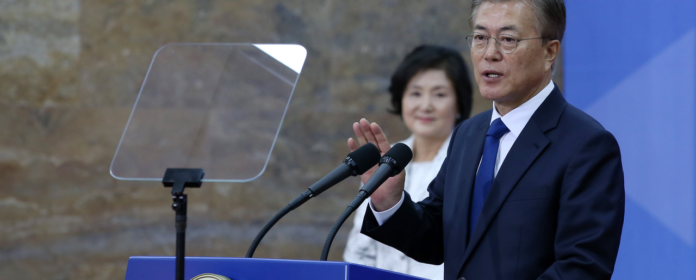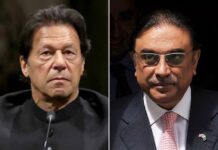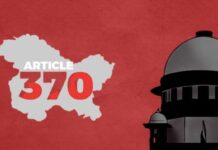As time runs out for South Korean President Moon Jae-in as his tenure ends in May 2022, two issues are confronting him that he wants to resolve. Both are tough. One is dealing with North Korea and working a path towards drawing North Korean leader Kim Jong-un to the drawing table for discussing the de-nuclearization process, and the other is more daunting than the first and that is his decision to phase out nuclear power from Korea’s total energy mix. While the first challenge has been there for quite some time and unlikely to go away so soon, for the second Moon is facing some sort of a self-contradiction as he is committed to fast track export of domestic reactors to central European countries.
By Prof Rajaram Panda
As one of the world’s most prominent nuclear energy countries, the industry not only meets almost a quarter of the country’s energy requirements but also exports its technology widely. Currently, it is involved in the building of the UAE’s first nuclear power plant, under a $20 billion contract. Moon wants to alter this strategic priority by phasing out it over some 45 years.
Moon’s phasing out announcement also goes against the growing demand inside Korea to revisit the country’s nuclear option in the wake of increasing threats from its immediate neighbour as well as fear of Japan taking a similar course. Also, like in Japan, the continued reliance on the US for its security, despite the latter’s commitment for extended nuclear deterrence, has come under strain in the wake of increasing pressure from the US to increase the security burden. This is a separate issue and thus remains outside of discussion here.
Critics cannot miss the import of the claims of Hungarian President Janos Ader during a joint press conference with Moon that both Korea and Hungary are committed to reach carbon neutrality by 2050, which they agreed cannot be achieved without nuclear energy. Such open declaration goes against Moon’s policy to phase out nuclear energy in Korea. Surely, the Opposition shall put pressure on Moon to clarify his actual stance.
If Moon really wants to phase out nuclear energy in Korea and replace nuclear power plants with renewable energy and coal-fired power plants by 2079, how much he can do as he is a few months away from demitting office is questionable. Even if a move in such direction is launched, concern on potential power shortage shall remain. According to the decommissioning plan of Korea’s existing 24 nuclear reactors, when each reach the end of their respective design life, the number should decline to 18 by 2031 and 9 by 2050. Explaining concern that the nuclear power industry might collapse if such a course is pursued, Moon justifies that pursuance of such a policy would help the industry by exporting technologies and reactor decommissioning business. Does such a policy stance really mean Korea is against nuclear energy policy as it claims that it is exiting the sector while at the same time wants to sell nuclear technology to other countries? Critics say that the paradox remains and Moon’s claims look unconvincing.
Park Soo-hyun, senior Cheong Wa Dae Secretary for Public Communication clarified that the country’s nuclear power plants shall continue to play their role until carbon neutrality is achieved by 2050 and what Moon committed to Ader is that Korea will not build any new reactors. If by adopting such a course Korea aims to be in a win-win situation that seems to be too far from the target. At a time when the security environment in the neighbourhood is rapidly deteriorating and threats from North Korea and China show no sign of diminishing, can South Korea afford to pursue a policy to dispense with nuclear, be it for power or otherwise? Only the credulous would believe Moon’s argument.
By choosing such a policy, Moon looks to business opportunities in other countries such as in Poland and Czech Republic who want to build their own nuclear reactors but lack technology. Since Korea possesses high-quality technology as well as experience, by exporting nuclear reactors Moon envisions a win-win situation for both exporting and importing countries. Irrespective of the merits of the case, the bottom line is that Moon does not have time left in office. If a hard-liner succeeds his in office next year, the whole process may be derailed at one stroke.
It is true that nuclear is a clean energy source and many countries in the world, including India, want to pursue the policy to increase their capacity to augment power from nuclear source. Signing agreements for civil nuclear cooperation that entails building new reactors by importing technology with caveats is a good source to prevent misuse of nuclear materials towards weaponisation. Even not being a signatory to the NPT, India too has signed civil nuclear agreements with many countries to augment its nuclear energy capability to meet its growing needs of power. Moon is targeting the Visegrad Group, an organisation of the Czech Republic, Poland, Slovenia and Hungary as potential clients for its nuclear technology for building nuclear power plants.
Poland has an ambitious plan to build six nuclear reactors by 2040. Korea’s Hydro & Nuclear Power is keen to offer APR1400 reactors with a total capacity of 8.4 gigawatts. Czech Republic too wants to build additional reactor in the southern region of Dukovany. If President Moon makes a deal before leaving office, the next administration shall find itself in a trick situation if it wants to annual the agreements. President Moon adopted the phasing out policy after taking office in 2017, citing safety concerns. May be his decision stemmed from the lessons Japan learnt from its Fukushima nuclear accident of March 2011 and does not want such case ever to occur in his own country.
So, Korea’s dilemma shall continue as policies should be consistent as it would involve treaty obligations and breaking such deals could be problematic. With 24 reactors in operation, Korea ranks as the world’s sixth-largest producer of energy from nuclear power, accounting for about 24 per cent of the country’s total energy needs. Two out of 24 reactors have been shut down and four are currently under construction. There were problems in units 3 and 4 of the Shin Hanul Nuclear Power Plant, which led these to shut down. The construction of the two reactors was stopped after Moon came out with his nuclear phase-out policy. This means the 790 billion won that had already gone into the project have gone down the drain.
At present, coal-fired power plants account for 35.6 per cent of total energy generation. The government plans to close down nuclear reactors completely as it wants to augment dependence on renewable to compensate for this. This is one of the many ways to achieve net-zero carbon neutrality by 2050. Korean energy experts are however not upbeat about the success of the plan as switch to renewable energy shall lack competitiveness for a considerable time.
Reliance on solar energy does not seem to be a viable option either as it can be produced now for an average of 3.5 hours a day. Dependence on wind power also does not look promising. Korea also lacks not only fossil fuel energy but is also short on renewable energy sources. If the Korean government is keen to expand renewable energy in the mid- to long-term, it needs to take a strategic approach by factoring in the country’s geography. Unless this is done, the alternatives would lack competitive economic edge.
This brings back into focus the role of nuclear energy and its future. Though phasing out nuclear energy is a global trend now, the switch to alternative energy sources shall be slower. Korea is no exception. Some countries aim to achieve carbon neutrality by continuing with nuclear power in the short term. For example, France wants to bring down dependence on nuclear energy from the current 75 per cent to 50 per cent by 2035, though it is going to invest 1 billion euro in nuclear energy research and development, including the production of small modular reactors (SMRs).
Similarly, England which plans to achieve carbon neutrality by 2050, is also building nuclear power plants. Japan which hogged global limelight following Fukushima nuclear accident in March 2011 and shut down all its nuclear reactors and brought down its dependence on nuclear energy from almost a quarter of its total requirements to zero has now revived some reactors after stringent safety checks and draws 6 per cent of its energy needs but has now decided to raise the ratio to between 20 to 22 per cent by 2030. In view of this, the Moon administration shall come under intense pressure, particularly from the business community, to pursue a similar policy to achieve carbon neutrality.
Moon administration’s policy of energy switch could have serious implications for business activities as there could be crisis in electricity power supply and consequent rate hikes. Particularly, the new measures, if implemented, would adversely affect the energy consuming manufacturers such as the semiconductors, automobile and steel industries. Korea Hydro and Nuclear Power President and CEO Chung Jae-hon, opines that carbon neutrality cannot be achieved if the new phase-out plan is pursued. What the government needs to seek is social consensus as electricity rates would be raised by 25.8 per cent in 2030 and 33 per cent in 2040 compared to 2017 if the nuclear phase-out continues.
The South Korean government is drafting new renewable energy law and regulations at present. In May 2020, the government announced its 2020-2034 plan – a long-term energy transition plan. According to the plan, renewable energy shall account for 40 per cent of energy needs. The share of liquefied natural gas (LNG) fired plants shall be maintained at 32 per cent and all coal-fired power plants will be shut down along with closure of nine nuclear plants, decreasing the share of nuclear power to 10 per cent. Space does not permit to go into further details.
EndnotesThis article first appeared in www.vifindia.org and it belongs to them.












